Infographic: 12 Steps to Manage Talent Risk

i4cp’s Talent Risk Management study found that less than one-half (45%) of companies have a process in place to address organizational-level talent risk. For organizations that don't address this type of talent risk, the pain is felt both internally (via negative impact on culture, productivity, and the ability to innovate and develop new products) and externally (through lost competitive advantage and customer satisfaction), all of which have negative impact on the organization's ability to grow revenue.
The infographic below lists 12 practices used by organizations that excel at managing talent risk.
Study findings suggest that talent risk management begins with a structured process to assess, prioritize, mitigate, and measure and monitor such risk. Talent risk management creates a process to identify the most critical job roles, organizational capabilities, and knowledge/skills/abilities needed to execute strategy. It also requires a talent planning process to close gaps and mitigate people-related risk through more customized talent management planning. And it requires ongoing measurement and monitoring to ensure talent risk activity is on track.






